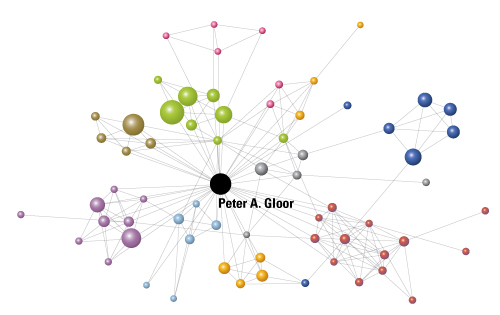What Email Reveals About Your Organization
By studying data from email archives and other sources, managers can gain surprising insights about how groups should be organized and led — as well as about optimal participation and communications patterns.
Topics
What if — far enough in advance that you could do something about it — you could gauge the likelihood that some of your company’s top performers were thinking about leaving? Or if you could see from the email interactions between your best salespeople and customers which communication behaviors had the most chance of generating successful results? It so happens that by sifting through data from such sources as email archives, Twitter feeds, and Facebook group pages, managers can in fact learn a lot about how to manage these and other areas of their organizations. They can then use this information to generate better results.
Over the last 15 years, I have worked with researchers at the MIT Center for Collective Intelligence, Wayne State University, the University of Cologne, and the University of Applied Sciences Northwestern Switzerland (FHNW), studying hundreds of organizations through the lens of their social networks as portrayed by email and other electronic archives. The high-level goal is to develop metrics and software tools that make measuring informal communication within organizations as straightforward as handling payroll and accounting. Much as enterprise software companies such as SAP SE specialize in helping companies monitor financial information and structured business processes, we seek to enable organizations to track informal knowledge flows.
By studying widely available internal data, we have mapped social networks in a variety of settings: R&D organizations at auto companies; bank marketing departments; sales teams at high-tech manufacturers; hospitals; and large consulting and process-outsourcing firms. In addition, we have studied open-source organizations such as software developers, Wikipedia editors, and online communities of patients with chronic diseases. Studying all of these organizations has helped us identify key criteria that distinguish high-performing organizations from underperforming ones and highly innovative teams from less creative ones. (See “Related Research.”)
I first noticed the distinctive communication behaviors of collaborative innovators back in the early 1990s while working as a postdoctoral fellow at the MIT Lab for Computer Science. Tim Berners-Lee, who is widely considered to be the creator of the World Wide Web, had recently joined our group as a visiting scientist, and his communication style stood out from that of others in the group. For instance, back then it was common for people to take weeks to answer emails, but Berners-Lee tended to answer his emails within minutes. Since that time, I have identified other communication patterns of successful organizations and tested their relationships with performance both in organizations and in a seminar I have taught with colleagues since 2005 at MIT, Aalto University Helsinki, and the University of Cologne.
A question that comes up before any research project that involves mining email archives and other communication has to do with privacy. Understandably, both managers and employees worry about the release of private information. In our work, we address this concern in three ways. First, we commit to doing anonymized analysis. We provide management with anonymized results aggregated by team or business unit; the only people who see individualized information about communication patterns are the individuals themselves. Second, we restrict most of our content analysis to email header information, which includes the sender, the receivers, subject, and timestamp. (We do use machine-learning software to evaluate entire messages for sentiment and emotionality. However, when using machine-learning-based language analysis, we look only at sentiment and patterns of new word usage, not the content of individual messages.) Finally, we commit to transparent communication. As we do our analysis, we hold regular status meetings with our research partners in which we describe the process and tell them about our findings. These meetings are not just for senior management but are also open to interested employees.
Indicators of Collaboration
By studying data from various sources (such as email archives, tweets, and blog links), our social network researchers have identified several indicators of how effective collaborative communication works. The indicators can guide managers in decisions about how groups should be organized and led, recommended levels of participation for group members, how quickly members should be expected to respond, the tone of the language that team members should use, and how technical the language should be. Here are some of our principal findings.
Type of leadership
Although one might expect that on a collaborative team everybody should be a leader, our research found that creative people work more effectively when they have strong leaders. For example, at Wikipedia, the epitome of creative collaboration, small groups with strong leaders complete quality articles much faster than larger groups without clear leaders. The same is true in medical research, where teams with a recognized leadership team have been ranked as more creative by senior management.
Yet as important as having strong leaders can be for creativity, we have also found that groups of leaders taking turns tend to work even better. We made this finding in the course of studying email communication among Eclipse open-source software developers. We measured the performance and creativity of the programmers, tracking creativity in terms of speed in implementing new features, and performance in terms of how quickly they fixed software bugs. We found that rotating leadership was the best predictor of creative teams. We subsequently found this pattern in dozens of organizational networks, including within our own seminar and among medical researchers developing innovations for the care of patients with chronic diseases. Teams in which different individuals took turns leading the group were more creative than teams in which one person was consistently in charge.
However, in settings where reliability is more important than creativity, steady leadership — rather than rotating leadership — is beneficial. For example, when studying post-anesthesia-care nurses at a large hospital, we found that patients tended to wake up from anesthesia faster if one senior nurse was in charge for the entire day.
Participation level
On teams, there is a difference between information consumers and information producers or “contributors.” We found that teams whose core members were each contributing a similar number of email messages were more creative than teams in which a few individuals were contributing most of the messages. In a different context, the research output of medical teams was rated as more creative when researchers took turns contributing, with senior and junior people rotating the main contributor position.
Increasing participation, however, isn’t always optimal. For account management teams at a global services company, for example, we found that customer satisfaction was higher when a few designated leaders communicated regularly with customers, rather than having a large number of employees communicate with the customer.
Response time
The speed of response and the number of “nudges” or “pings” it takes before a prospective communication partner answers his or her emails tend to be excellent indicators of employee and customer satisfaction as well as mutual respect. For example, at a consulting company in 2008 (before smartphones were popular), we measured the email response times for different departments. Six departments took an average of about three days to respond; one department took almost six days. It turned out that the manager of that department had just been replaced, and employees were not happy about it. Of course, in the age of smartphones, response times have gotten faster; average response times for employees getting hundreds of emails per day has dropped to about two hours.
However, depending on the context, the speed of response isn’t always significant. For example, we studied a provider of business services (including accounting and HR services) with call centers in India, the Philippines, Mexico, and Eastern Europe to see if speed of response was linked to customer satisfaction. In general, we found it had no direct influence on customer satisfaction. However, we did find a significant correlation between the speed with which the customer answered the account manager’s email and his or her satisfaction: Happy customers generally answered emails faster. This indicates that it is not enough to answer customers’ messages quickly — one also needs to solve their problems (although, to be sure, answering messages slowly is one way to create unhappy customers).
Language tone
Although we do not look at messages for their content, we do use machine-learning software to evaluate them for their sentiment and emotionality. Indeed, the tone of the language salespeople use with customers can provide important indicators about the state of the relationship. For example, in reviewing the email archive about a process-outsourcing project with a global services provider, we found that the more positive language a salesperson in that organization used with the customer, the less happy the customer was. In other circumstances — for example, a team involved with medical research — we found that a mixture of positive and negative language in the same message indicated higher performance. In assessing employee attrition, we found that people who were most likely to leave their jobs became less emotional in their use of language and contributed less leadership in a rotational setting in the three months leading up to their resignations than people who were not planning to resign.
Shared context
High-functioning teams tend to define their own language. The World Wide Web brought about new terms such as “HTML” and “HTTP” and gave new meanings to existing words (including “web”). In our research, we looked at new-word usage in two ways. First, we considered the frequency of rare words in the entire text collection. We found, for example, that the more complex the language that salespeople use, the more dissatisfied the customer. Second, we tracked the diffusion of new words in a community. When somebody used a new word in a group, we measured how quickly the word got picked up by others. The more successful somebody was in introducing new words, the more influential she or he was.
Putting the System to Work
The indicators of collaboration we have discussed have been integrated into a software tool called Condor that our team at the MIT Center for Collective Intelligence developed over the last 10 years. Condor calculates the signals automatically from email, Twitter, or other communication archives. The indicators, together with a map of the email network, can be used as a dashboard to measure communication and can be shared with employees. We call the process of showing people their own communication behavior “virtual mirroring.” Employees get a “virtual mirror” of their communication pattern (based on their email archive) and can see how they rank in comparison with others on the various dimensions. Typically, employees receive their own information and information about how they interact with their department.
Based on our research, we have developed a four-step process for analyzing and improving the performance of organizations, using the indicators calculated by Condor.
1. Define social network metrics and communication patterns. As an initial exploratory step, we analyze and quantify the communication patterns and social network structure embedded within organizational communication archives. We use this data to visualize the social network and develop initial hypotheses about what communication patterns will be good for business success.
2. Compare structural attributes with business success. Next, we compare communication behavior noted in the first step with patterns we have seen as signs of better connectivity, interactivity, and sharing among individuals in the network. We correlate these indicators with success and failure metrics that are important to the organization (for example, customer satisfaction metrics). These patterns vary significantly depending on the type of organization, the industry, and the individuals being measured. For example, we found that for a team of medical researchers it was better to use more emotional language, while for sales teams in a large high-tech manufacturer it was better to use more matter-of-fact language.
3. Mirror behavior back to individuals and teams. By showing people how their own behavior and the behavior of their team differ from best practices in other comparable teams, you can help them alter their behavior for better performance. Seeing how a team communicates can be an eye-opening experience for team members and prompt fundamental changes in their behavior. For example, in an 18-month project with a process-outsourcing provider, we could show that the satisfaction of customers whose provider teams were applying this process was improving while the satisfaction of customers whose provider teams did not use this process declined.
4. Devise a plan to optimize communication for greater success. Once managers figure out which indicators are correlated with success and failure, they can change employee communication behaviors, which can lead to outcomes such as more successful deals, more satisfied customers, and happier employees. For example, when account managers at a large service provider were told about how they were communicating compared with their peers and what sort of communication behavior their customers liked, they were able to achieve a 5% increase in customer satisfaction within six months.
By looking at the various signs of collaboration from electronic communication records, managers can get a unique view into the nervous system of their organization — allowing them to optimize communication for superior collaboration and innovation.







Comments (3)
Daniel Siles
C S
Rishe